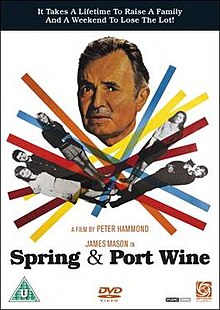Spring and Port Wine
| Spring and Port Wine | |
|---|---|
| Written by | Bill Naughton |
| Date premiered | October 1959 |
| Original language | English |
| Genre | comedy |
| Spring and Port Wine | |
|---|---|
 |
|
| Directed by | Peter Hammond |
| Produced by | Michael Medwin |
| Written by | Bill Naughton |
| Starring |
James Mason Diana Coupland |
| Music by | Douglas Gamley |
| Edited by | Fergus McDonell |
|
Release date
|
|
|
Running time
|
101 minutes |
| Country | United Kingdom |
| Language | English |
Spring and Port Wine is a stage play by Bill Naughton which was turned into a film (1970). The story is set in Bolton and concerns the Crompton family, in particular the father, Rafe, and his attempts to assert his authority in the household as his children grow up.
It began life under the title My Flesh, My Blood as a BBC radio play, broadcast on 17 August 1957 in the Saturday Night Theatre strand. By April 1958 a BBC TV version had been broadcast and in October 1959 a stage adaptation was presented at the Bolton Hippodrome.
Retitled Spring and Port Wine, the play was first produced in Birmingham prior to opening at London's Mermaid Theatre in November 1965, produced by Allan Davis and Michael Medwin in association with the Mermaid Theatre Trust; Davis was also the director. In January 1966 the production transferred to the Apollo Theatre on Shaftesbury Avenue, with Alfred Marks, Ruth Dunning, John Alderton, Jennifer Wilson, Ray Mort, Gretchen Franklin and Melvyn Hayes in the cast. Subsequently moving to the New Theatre in July 1967 and the St Martin's in June 1968, it achieved a West End run of 1,236 performances. Alfred Marks, meanwhile, had left the cast and from 1967-8 played the lead role of Rafe Crompton in an Australian tour.
The play was adapted (by N. Richard Nash, who was uncredited) to a setting in the United States under the title Keep It in the Family, which ran on Broadway at the Plymouth Theatre for five performances in September 1967.
The play was filmed in 1969 - produced, once again, by Michael Medwin - and the result is a valuable time-capsule in that it depicts a Bolton of large, long-gone chimneys. Other parts of the film show street scenes and wide shots of the town as it was at the time of filming. It was filmed as St. Peters Way was being constructed and whilst many of the old industrial buildings remained. The lives depicted are very real for the period and this film captures an industrial town in transformation.
...
Wikipedia
